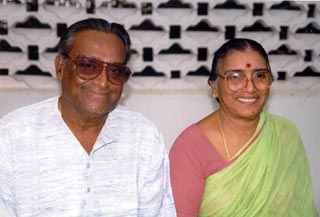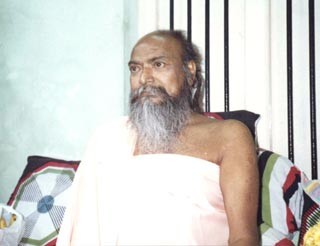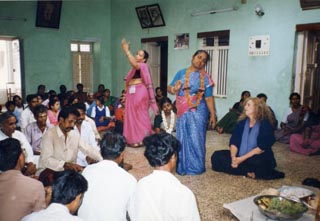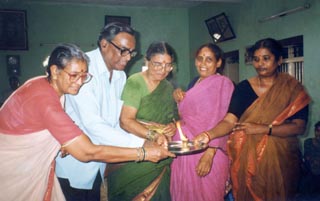SOUL CONNECTIONS HOME | PREVIOUS PAGE | NEXT PAGE

Mr. Kommireddi Gopanna and his wife, Chudamani.
K. Gopanna
Devotees have soul connections, and sometimes they have family connections. Mr. Kommireddi Gopanna’s parents, a grandfather and an uncle were Swamiji’s devotees. He and his wife, Chudamani, have children and grandchildren who are devotees.
Mr. Gopanna is one of the trustees in Adivarapupeta. He and his wife now spend most of their time in the ashram, watching over its activities. Mr. and Mrs. Gopanna kindly provide for the Western visitors who need a little extra attention, like a cup of coffee or tea, or when the famous spicy heat of Andhra cooking proves too much. They welcome and serve guests like family.
They would say that it is Swamiji and that they are only doing what Swamiji instructs. But there is no question they enjoy serving visitors.
![]()
The Kommiredi family is from Kakinada, a seaport on the Bay of Bengal that became prosperous under British rule from the import of timber from Burma. The street on which they live bears the family name.
Their family house was an oasis for me on my way to and from Adivarapupeta. There I could enjoy simple pleasures that, back then, were not available at the ashram: sitting at a table to eat, a sofa, a bed, a hot bath, and a phone that worked. The best curds I have eaten were in that house. The family’s hospitality is generous, and their kitchen superb. When I mentioned that I missed tomatoes in my diet, they prepared a fresh tomato curry that I will never forget.
Swamiji enjoyed staying at that house. He rested there on his last journey to Adivarapupeta, and each time he came to Kakinada for dialysis. It was in that house that I saw Swamiji for the last time.
![]()
Nearby Yanam was French colony until 1954. Mr. Gopanna told me the story of his ancestor who was the last woman allowed to commit sati in Yanam. Her request went to the French governor who passed it on to his superiors in France. Inexplicably, as in miraculously, her request was granted. Her desire was sincere and her act was spiritually sublime.
Swamiji explained to Mr. Gopanna that because of his ancestor’s selfless sacrifice, her family was blessed for seven generations. He added that he had seen her form wandering in the Kommiredi house, and that the family had neglected to give her the honor that was due her. He encouraged the family to pray and make offerings to her spirit.
![]()
The coil in Gopanna’s father’s car kept going out. It would overheat and stop working. In the summer they put wet cloths on it to keep it cool. One day they were visiting Swamiji at the ashram and his father was anxious to return home before dusk. He did not want to risk the coil going out and being stuck in the dark. Swamiji told them to have his prashad and then go. His father complained that he was anxious to leave immediately because the car was giving him trouble.
Swamiji teased him, “Oh, so there is some disease for your car?” Swamiji gave his father some vibhuti. “You keep this in your car always. Don’t worry about the car. You have my prashad and then you go.” They left at about nine o’clock in the night. They had no problem with the car since.
It was the same black 1952 Morris Major that Mr. Gopanna was driving when he told me this story. He kept it because it his father was very attached to it, maintaining it in excellent shape, and because Swamiji used to ride in it.
![]()
When Mr. Gopanna was ten years old, he had a very serious accident which almost took his life. He had been jumping from one tree to the next in imitating Tarzan movies that were popular back then. He missed one jump and fell to the ground below, breaking both bones in his right forearm. One of the bones stuck out of the flesh and dirt was ground into its marrow.
The injury was very serious and became badly infected. Gangrene set in and the doctors gave him thirty-six hours in which to turn the corner and begin recovery or he would die. In his delirium, he had a vision of Shirdi Sai Baba. The yogi appeared tall, over six feet, with a beautiful fair complexion and long, peaceful face. He had no previous connection or interest with Shirdi Sai Baba. He only recognized the person in the vision from a photograph in one of his grandfather’s books.
He recovered quickly and regained full use of his arm and later became a champion cricket and tennis player.
Mr. Gopanna was always too timid to ask Swamiji about the connection between Swamiji and Shirdi Sai Baba. Mataji encouraged him to ask about the connection because Swamiji had explained to her that Shirdi Sai Baba’s devotees would come to Swamiji. He told Swamiji about the incident and Swamiji just smiled knowingly.
![]()

Shri Swamiji at the Gopannas' house in Kakinada, the day he arrived on his way to Adivarapaupeta, March 9, 1994.
Below: Bhajans, bhava samadhi and arthi to Swamiji
at the Gopannas' house in 1997


Mr. Gopanna’s parents would invite Swamiji visit their house in Kakinada. All sorts of important people would come for Swamiji’s darshan, business people, politicians, landowners and the like. Their cars would be parked along the entire street on which their house was located. As is the custom with most people affluent enough to have a car in India, they would also have a personal driver. While the masters were inside the house, the drivers would wait outside in the car.
Swamiji would always insist that everyone receive his prashad before leaving. He called Gopanna and instructed him to personally take prashad to each driver outside and make sure they ate. He was to do it personally because if a servant were asked, they may simply say they did it when they didn’t.
![]()
Mr. Gopanna was an avid and successful sportsman, playing cricket for the all state team and competitive tennis. As the years wore on, his knees suffered the strain of the heavy work. They got so bad that after a day’s tennis or cricket, they swelled painfully and it took several days before he could walk or bend them without severe pain. He was the secretary of a sports club where several prominent physicians were members. They all told him that his athletic days were over. He suffered terribly from the pain and stiffness.
One day he was at the ashram enjoying Swamiji’s darshan. At one point, Swamiji asked all the devotees to go up on the roof to enjoy the evening air and take some prashad. All the others got up and left, but Gopanna’s knees were giving him so much pain that he managed to get up only with great difficulty. Swamiji saw this and asked him what was the problem. Gopanna told him how his knees had gotten so badly damaged from playing cricket and tennis and how he would never be able to play again. As he thought of himself crippled after taking such pleasure in being active, Gopanna could not help but crying.
Swamiji asked him if he was taking vibhuti. Gopanna said he put some on his forehead after each bath. Swamiji said, “Not that. Are you eating vibhuti? You should be eating vibhuti regularly.”
He started eating vibhuti regularly and the pain and swelling in his knees disappeared. He has continued to eat vibhuti and he has had no problems or limitations in his knees since.
![]()
Mr. Gopanna relates this incident as an example of how he seeks Swamiji’s guidance in the smallest matters, and how Swamiji provides detailed guidance.
There was a rather unpleasant altercation over pouring the slab for the temple roof. The main engineer insisted that the slab had to be six inches thick. This engineer had worked with Swamiji before the mahasamadhi. A younger and more qualified engineer insisted that four inches were more than sufficient for strength. After all, he explained, there was no second floor to be built so the slab did not have additional weight to support.
One of the other Adivarapupeta trustees, Mr. Ramana, got upset over the engineers’ bickering and announced that he would decide the issue. The roof would be four inches thick, and he threw out the engineer who was arguing otherwise.
The fired engineer was leaving through the village as Mr. Gopanna was driving to the ashram. The engineer warned him about the altercation and the issue over the roof slab. Gopanna was not looking forward to getting involved.
When he arrived at the ashram, he was very troubled. He went to the Samadhi and prayed there for a half an hour. He got up to write some receipts in the office, and within five minutes Swamiji was calling him. He was in bhava upon Chitamma.
Gopanna went to Swamiji who asked him what was the problem and why did he call for Swamiji. Gopanna explained that there were hundreds of workers assembled to pour the slab roof, yet there was a big argument over whether to pour four or six inches until finally Mr. Ramana decided to make it only four inches. Gopanna did not know what to do. Swamiji told him that whatever they were doing then, that was right.
They saved about two tons of steel and concrete costing twenty to thirty thousand rupees, about $10,000.
![]()
Mr. Gopanna used to come with his grandfather to visit Swamiji during the last four years of his tapas. On one occasion, long before Swamiji left Adivarapupeta, before he even got an invitation to visit nearby Kakinada, Swamiji told them that he would be leaving Adivarapupeta to travel throughout India and then abroad. He said that foreigners will come to him and they will wear his vibhuti.
In those days, there was nothing around the Dhyana Mandir except fields. Swamiji would gesture towards the south side of the ashram property, towards the village, and tell the villagers that in the future, all that area would be built up.
Now this is the area where the guest building and kitchen buildings have been constructed, and where people have been told in dreams and through trance that two-story apartment buildings will be constructed along both sides of each driveway.


